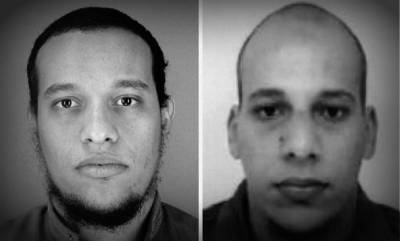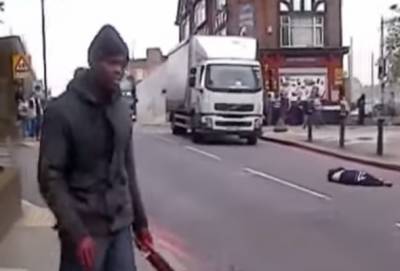The Kouachi Brothers: Inaugurating a New Era of Jihad

On January 7, 2015 Cherif and Said Kouachi, whose ties to the French jihadi scene extend for a decade, made history by storming the Charlie Hebdo offices in Paris, France, and massacring many of those they found inside. The two brothers’ attack may have inaugurated a new era, wedding operations carried out with available tools to high-visibility civilian targets in the West.
Most recently, this style of operations was also evidenced in the May 3, 2015 attack in Garland, Texas, during which Elton Simpson and Nadir Soofi attempted to attack a contest to draw the Prophet Mohammed. Although the attackers were shot and killed by police officers before they were able to access the cartoonists at the Curtis Culwell Center, they injured a security officer before they were killed.
 Cherif Kouachi's radicalization was characteristic of the jihadi pipeline developed to radical French Muslims to the battlegrounds during America’s war in Iraq: happening as part of a network of worshippers in a Parisian mosque (where Kouachi was linked to jihadi recruiter and facilitator named Farid Benyettou). Arrested in 2004, before he was able to leave France for Iraq, Kouachi was then imprisoned alongside Djamel Beghal, a jihadi recruiter and graduate of al-Qaeda's (AQ) training camps who was allegedly sent to France by the group’s top leadership to establish domestic cells. In 2011, the brothers reportedly trained in Yemen with al-Qaeda in the Arabian Peninsula (AQAP), the AQ affiliate that has sought to carry out ambitious attacks against Western targets, such as Umar Farouk Abdulmutallab's attempt tom Northwest Airlines Flight 253 in December 2009, and the October 2010 attempt to conceal plastic explosives in cargo planes flying to the United States. They returned to France, where for a dozen years they concealed outwards signs of their radicalization, and on January 7, 2015 they carried out an attack against a target that had been in jihadi cross-hairs for years.
Cherif Kouachi's radicalization was characteristic of the jihadi pipeline developed to radical French Muslims to the battlegrounds during America’s war in Iraq: happening as part of a network of worshippers in a Parisian mosque (where Kouachi was linked to jihadi recruiter and facilitator named Farid Benyettou). Arrested in 2004, before he was able to leave France for Iraq, Kouachi was then imprisoned alongside Djamel Beghal, a jihadi recruiter and graduate of al-Qaeda's (AQ) training camps who was allegedly sent to France by the group’s top leadership to establish domestic cells. In 2011, the brothers reportedly trained in Yemen with al-Qaeda in the Arabian Peninsula (AQAP), the AQ affiliate that has sought to carry out ambitious attacks against Western targets, such as Umar Farouk Abdulmutallab's attempt tom Northwest Airlines Flight 253 in December 2009, and the October 2010 attempt to conceal plastic explosives in cargo planes flying to the United States. They returned to France, where for a dozen years they concealed outwards signs of their radicalization, and on January 7, 2015 they carried out an attack against a target that had been in jihadi cross-hairs for years.
And, yet, despite this pedigree, the attack on the Charlie Hebdo headquarters is fundamentally different from AQ’s previous attempts to stage attacks in the West, such as the 7/7 London bombings.
Unusually, the two men coordinated their attack with that of Amedy Coulibaly, a similarly radicalized jihadi who viewed himself as a soldier of the Islamic State (IS). While the Kouachi brothers carried out the operation against Charlie Hebdo—which AQAP claimed to have both commissioned and funded—Coulibaly laid siege to a Kosher supermarket in Paris. The hybridization of two simultaneous attacks, against two distinctive soft targets, appeared to have taken even AQAP by surprise. In claiming responsibility for the Charlie Hebdo operation, the Yemeni AQ branch claimed only to have funded and directed the Kouachi brothers, adding that it was “it was a tawfeeq [good fortune] from God that their operation coincided with that of Amedy Coulibaly.” This innovation, coordinating with a separate attacker, underscores the overall impression that AQAP dispatched the two brothers back to France with funds and a mission, but relatively little in the way of precise instructions or oversight.
 Secondly, the Kouachi brothers eschewed the explosives most closely associated with previous attempts at Western attacks. While dramatic and high-impact, explosives require significant development time and present a high-risk of detection and capture. Instead, the brothers carried out the attacks using firearms: a much more accessible weapon, and one that has been encouraged by AQ since at least 2011. A separate strand of jihadi incitements, recently associated with calls for operations issued by Syria-based fighters, has focused on mobilizing attackers to use knives and cutlery. Edged weapons provide an even more accessible tool, and one that closely reflects a theme of operations that has played out in the United Kingdom. For example, Roshonara Choudhry's attack on Stephen Timms in May of 2010, and Michael Adebolajo and Michael Adebowale's decapitation of British solider Lee Rigby on a London street in May of 2013, each utilized edged weapons.
Secondly, the Kouachi brothers eschewed the explosives most closely associated with previous attempts at Western attacks. While dramatic and high-impact, explosives require significant development time and present a high-risk of detection and capture. Instead, the brothers carried out the attacks using firearms: a much more accessible weapon, and one that has been encouraged by AQ since at least 2011. A separate strand of jihadi incitements, recently associated with calls for operations issued by Syria-based fighters, has focused on mobilizing attackers to use knives and cutlery. Edged weapons provide an even more accessible tool, and one that closely reflects a theme of operations that has played out in the United Kingdom. For example, Roshonara Choudhry's attack on Stephen Timms in May of 2010, and Michael Adebolajo and Michael Adebowale's decapitation of British solider Lee Rigby on a London street in May of 2013, each utilized edged weapons.
However, although jihadi propagandists such as Adam Gahadn have repeatedly urged domestic lone wolves to carry out attacks with weapons at hand—particularly firearms—and to eschew contact with the central organization this guidance was not often followed until the Charlie Hebdo attacks.
In part, the lack of precedent for high-impact domestic shootings in the West* may have followed from the relative lack of attention paid to jihadi attacks carried out using handguns. Until the Charlie Hebdo attacks, jihad-inspired shooting operations—such as the one carried out by Nidal Hassan—have tended to attract attention for aspects of the operation unrelated to the attack. For example, coverage of Nidal Hassan's November 05, 2009 attack on the Fort Hood military base have often focus on Hassan's position as a member of the United States Army. An aspiring attacker without these credentials may feel unable to duplicate this role, or, indeed, gain similar access to hard targets such as a military base.
Importantly, responses to both the Charlie Hebdo attack and, most particularly, the Texas attack, demonstrated to prospective jihadis that they can carry out violence against accessible, soft targets and have their operation associated with the jihadi group of their choice—either AQAP or IS.
As in the attack on the Charlie Hebdo offices, the Garland attack dominated the news cycle for days after the operation, ensuring notoriety for both the attackers and online jihadi instigators. The latter’s claims of responsibility for IS, bravado, and incitements for additional attacks were endlessly repeated on social media and via news organizations. Importantly, responses to both the Charlie Hebdo attack and, most particularly, the Texas attack, demonstrated to prospective jihadis that they can carry out violence against accessible, soft targets and have their operation associated with the jihadi group of their choice—either AQAP or IS. As well, the two attacks demonstrated that local attackers without any particular access to high-profile targets and who are already known to security organizations—in Elton Simpson for having already failed to join the jihadi battlefields—can be feted as mujahideen.
*Although previously rare in the West, mass shootings have become a hallmark of Southeast Asian organizations. The Tehrik-e-Taliban Pakistan (TPP) has been particularly aggressive in carrying out such operations against civilian, government, and military targets.